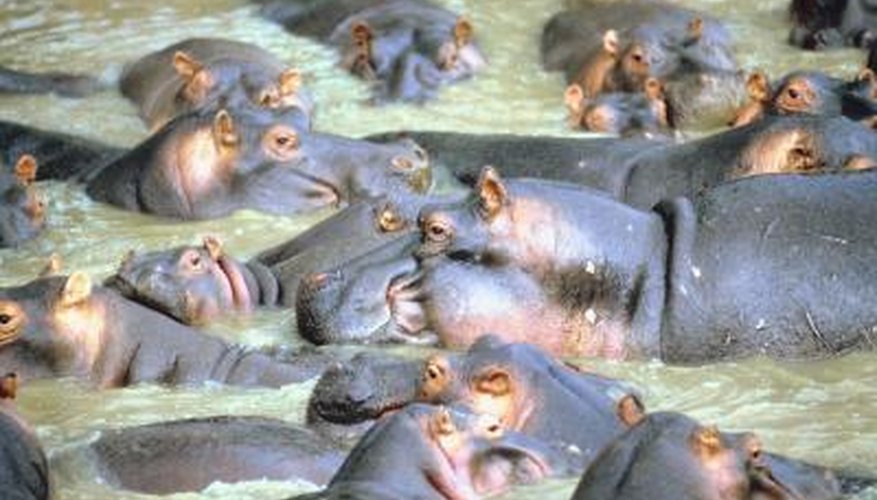Hippopotamuses reach sexual maturity at around age 8. A female hippo gestates, one calf at a time, every 2 to 3 years from the time of her first conception -- at about age 8 -- until the end of her life. Hippos are native to sub-Saharan Africa, but they are sensitive to the sun, so they spend much of their lives in or very near standing bodies of water, using the water and mud to keep cool and to cover their sensitive skin. Many of the hippo's reproductive systems reflect its reliance on the water -- the hippo mates, gives birth and nurses underwater.
Reproductive Organs
The male hippo's reproductive organs are like those of most mammals, except that his testicles do not fully descend, and he doesn't have a scrotum. Instead, the sperm mature and are stored in the epididymis. The epididymis runs from the male hippo's head, along its body and into the tail. The penis remains retracted into the male hippo's body unless the hippo is mating, so sexing hippos can be difficult.
The female's reproductive organs are typical of mammals, with ovaries, both of which ovulate, short Fallopian tubes and a Y-shaped uterus. The fibrous, interlocking ridges that run the length of the female hippo's vagina is unique to the female hippo's reproductive system; however, the ridges' purpose isn't known. The female hippo also has two diverticula that project from the vagina's vestibule. Their purpose isn't known either.
- The male hippo's reproductive organs are like those of most mammals, except that his testicles do not fully descend, and he doesn't have a scrotum.
- The fibrous, interlocking ridges that run the length of the female hippo's vagina is unique to the female hippo's reproductive system; however, the ridges' purpose isn't known.
Mating
Hippos breed all year, but mating increases during the dry seasons when hippos congregate at water holes. Births peak during the rainy season; they begin in December and peak during March to June. Though they may reach sexual maturity years earlier, both males and females usually first begin mating at around 8 years old.
- Hippos breed all year, but mating increases during the dry seasons when hippos congregate at water holes.
The hippos mate underwater, during the female's three-day cycle in which she is able to conceive. Only the herd's bull male can mate with the females, though during the period when many of the herd's females are in the midst of their fertility cycle, there might be an increase in aggression by both males and females eager to mate.
Gestation
The hippo gestation period is 7 to 8 months long, which is short in comparison to other large mammals such as elephants (which gestate for 22 months). Before giving birth, a mother hippo may separate from the herd and return only after a month or two, especially if she is gestating a male.
Birth and Newborn Care
Hippos are born underwater and swim to the surface to take their first breath. Why hippos birth in the water is unknown, though it's thought to serve as protection against land-based predators.
Newborns are approximately 50 inches long and between 27.2 and 49.9kg. The mother produces milk from the calf's birth until it is weaned at 6 to 8 months old, though the nursing period will increase in periods of food scarcity. To protect herself from the sun and sunburn, the mother spends much of her time in water too deep for the calf to stand in; the calf spends much of its time resting on its mother's back, and nurses underwater.
- Hippos are born underwater and swim to the surface to take their first breath.
- The mother produces milk from the calf's birth until it is weaned at 6 to 8 months old, though the nursing period will increase in periods of food scarcity.
